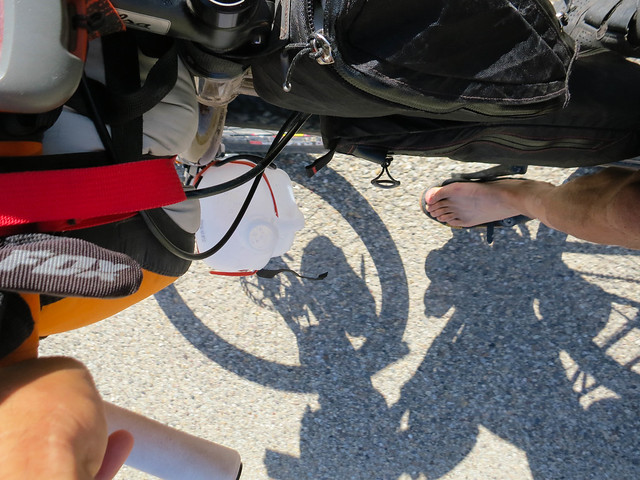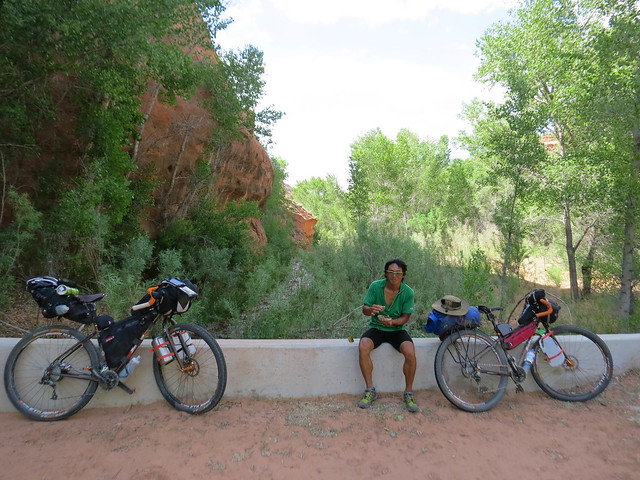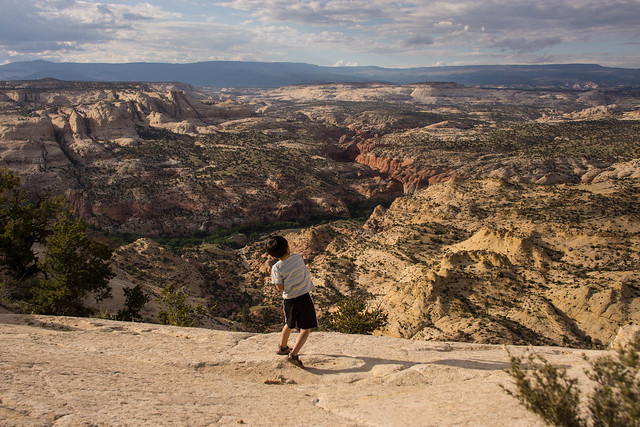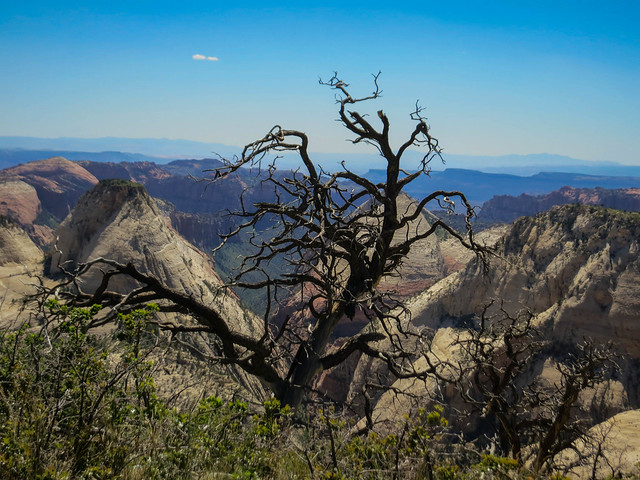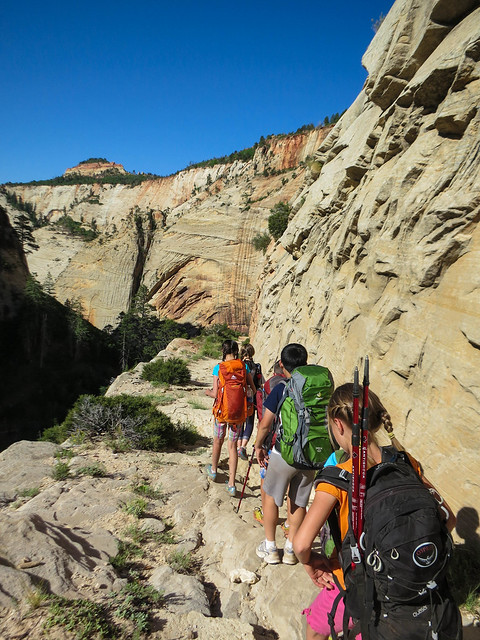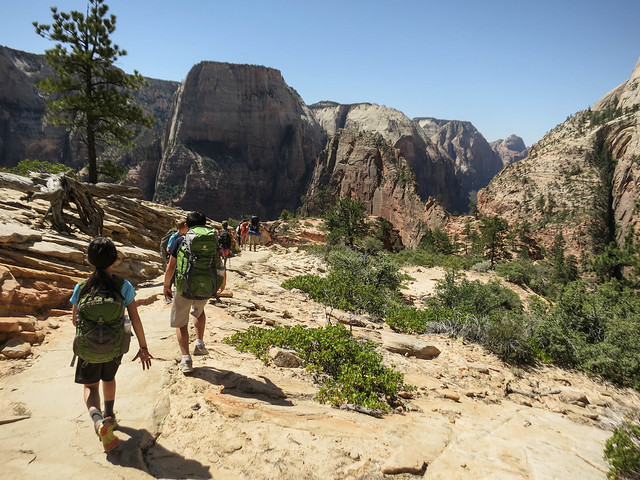I spent four days skiing in and around Chamonix with my friend Talley. Four days, four tours, four great lines. We were guided by Adam George, who despite the challenging weather, always came through with the goods. It was a very nice taste. I'd love to go back.
Here, roughly, are the lines we skied.
Day 1 -- We ascended the Aiguille du Genepi and then dropped off towards the Glacier du Tour. And descended an old iron chain back to the Le Tour resort.
Day 2 -- We ascended from Les Houches towards the Aiguille du Gouter, and then descended the Trappier Couloir, under some seracs, through some giant runnels and back to Les Houches.
Day 3 -- We spent the day in the Aiguilles Rouges, starting by riding the Flegere cable car, climbing a steep couloir and then skiing off the northeast face of the Ecrenaz, interrupted by a rappel, and exiting at Buet where we enviously eyed a croute de fromage.
Day 4 -- We followed the sun to Switzerland where we skied off the Grand Chavelard.
SLC Samurai
a training and adventure journal
Monday, March 23, 2015
Monday, June 23, 2014
Backcountry Bike Tour: SLC to Lake Powell and Back
Brother Aaron and I left Salt Lake on our bikes on June 5 and returned to Salt Lake late June 14, 2014. Between that time we rode about 80 hours, 875 miles and 60,000 vertical feet through Utah's desert and mountains. It was exactly the adventure I was hoping for.
Day 2: We awoke early, anxious to get to Wolf Creek Pass. On Duchesne Ridge, we were met with snow. Much of the time, we were able to ride our rigs across the frozen snow. Sometimes though we were met with muck and slush. We connected to pavement at Wolf Creek Pass and descended through Hanna and Tabiona, and then rode to Duchesne. From Duchesne, our GPS route led us into an alfalfa field. After we got that straightened out, we pushed out of Myton into a brutal headwind, riding through the Uinta Basin and the thumping of oil/gas wells. A few minutes before all the light of the day was gone, we turned off the road and set up camp. On a scale of 1-10 with 10 being "I wish I had a flame thrower," swarming gnats were a solid 9. We threw up our tents and dived inside for cover. 101 miles, 4044 vertical, and 14 hour day.
Day 3: The gnats nibbled at us throughout the day. We climbed Gate Canyon and entered Nine Mile Canyon. We were short on water and happy to reach Nine Mile Ranch where we filled our bottles, dunked our heads, and hand-washed our jerseys. "Water's free," the campground host said, but we handed him $4. Soon we had climbed out of Nine Mile Canyon and had a downhill and relatively fast 15 mile cruise into Wellington where we rode the highway (including a 1 mile stretch of I-70) to Green River. The tailwind from Wellington to I-70 junction was killer. 112 miles, 4123 vertical gain, 13 hrs.
Day 4: We arrived in Moab via mostly backroads before lunch. I was feeling pretty thrashed. Eating at a chinese buffet, showering and laundering my one set of riding clothing (while showering) in the Moab rec center, and then taking a nap helped. We ate an early dinner and then pedaled west toward Hurrah Pass. We climbed Hurrah Pass as the sun was setting and descended toward the Colorado River to find a place to camp. 70 miles, 3780 vertical gain.
Day 5: We rode the Lockhart Basin road. I'd been on the lower portion several times, but the upper portion was surprising in that it was rougher, harder to follow, more ups and downs, and more technical. We spent 1.5 hrs being lost after trying to follow our GPS route. Mapping software is not always up to date. Don't trust it. Getting back on route required some serious bike packing up what was essentially a small cliff. After we got on track, we were able to steadily tick miles off. It got hot and we slowly drained our water stores. I knocked my Jetboil over and spilled boiling water on my thigh. At the end of the Lockhart road, we put up tents in the shade of Hamburger Rock and took a much needed siesta. We rode to Indian Creek (Gnats were a 9.5) and a researcher/rancher was kind enough to let us fill our water bottles at her ranch. 58 miles, 5305 vertical gain. Hard and hot day.
Day 6: Our campsite last night was one of the better ones, surrounded by high red cliffs and under a large juniper tree. I used precious water to take a towel bath last night, but since we are heading into the mountains, I am confident water will be available. We start down the Beef Basin road, and then turn towards Cottonwood Creek and find a NFS road that will take us to Elk Ridge over the south Manti-Lasal Mountains. We pass up a good water source at the base of the climb, but after we top out are worried that we won't find water. Should we just go to Blanding? On the plateau however, we find a small spring. On the descent, I crash quite heavily and skin up my left arm and side, particularly my leg. Aaron drips precious water over my wounds with his leaky bottle, which had fallen off his bike and been punctured. I put bandages where skin had been scraped off and we continue through the Ute reservation. Eventually, after a somewhat circuitous route and deciding that our depleted water stores and dwindling light require us to stop puttering around on dirt roads, we exit onto a paved highway 15 miles outside Blanding. Thinking Lake Powell is only 45 miles away, we turn away from Blanding, hoping to make it to Lake Powell on our last water stores. Before it gets dark, we eat a meal. Without enough water to camp, we pedal through the dark. After riding 20 miles, Lake Powell is more than 45 miles away. We see that Natural Bridges National Monument, and more importantly a visitor center with running water, is a 4 mile detour. We veer off the road into the sage brush, put up our tents, and try to sleep. Earlier that day, a mini-tornado blew over me, caking my sweaty self with a layer of grit and sand. Sleeping dirty is uncomfortable. Counting on getting water at the visitors center, I drain my bottle. 78.5 miles, 7,954 vertical gain, and 14:15 hrs.
Day 7: We find water at the visitor center. I'm able to take a towel bath in the bathroom. After a couple days in the desert, running water is a luxury. We ride another 15 miles, and finally, Lake Powell is 45 miles away. Food-wise, I have a handful of beef jerky, 2 Gus, 4 Hi-Chews, and a drink mix left. I roll in to Halls Crossing, Lake Powell with a drink mix. We get a ride across the bay to Bullfrog, take a shower, stock up on some convenience store food, and eat at a restaurant. Riding through the desert between Moab and Lake Powell I had fantasies of diving into the lake. But once we got there, the winds were high and the water was brown. Still, it was nice to get there. That evening, we started up the Burr Trail. 69.6 miles, 2,548 vertical feet gained, 12:30 hrs.
Day 8: We rode the Burr Trail to Boulder. Due to a throbbing Achilles, I pedal long stretches barefoot. On the Burr Trail, we are given water by a French family who is driving around the world. We fuel up in Boulder and under a full moon climb the Boulder Mountain to the top of the Aquarius Plateau. 79.1 miles, 9,742 ft gained, and 12:30 hrs.
Day 9: It was now Friday. We were on the Boulder Mountain. I wanted to avoid being absent from home on Sunday, Father's Day. There was still snow on the Skyline Drive. Our bodies were tired, scraped, and bitten. We needed at least 3-4 days to connect the Skyline Drive with the Wasatch mountains. Aaron and I elected to forego our route through the mountains and to make a 105 mile push on the pavement to Gunnison, where we grew up and where our parents have a home. We are battered by a brutal headwind for the first 60 miles. At about 5:00 pm, the winds favor us, and we ride the last 45 miles in under two hours. We make a steak dinner and are happy to sleep in real beds. 105 miles, 6,400 vertical gain.
Day 10: Our final day, we hope. A 135 mile push from Gunnison, Utah to Salt Lake. Again, on pavement. All day, it feels unusually cool. Is it unusually cool or have we acclimated to the desert heat? Massive, diminishing, brutal headwinds, again. Access to running water and convenience stores is nice. I stop for a Coke in Levan. I stop for a Coke in Nephi. I stop for a Coke in Payson. I stop for a Coke in Provo. It's 10:00 pm now and finally, in the shelter of the city, the headwinds have dissipated. Aaron and I crank our bikes down 1300 East at 20 miles per hour. Soon, I am home. 135 miles, 1,200 vertical gain.
Day 1: We left SLC, climbed up Big Cottonwood Canyon to Guardsman Pass, descended to Midway and Heber, and then climbed up into the Uinta National Forest. We were surprised and slightly disappointed to log only 62 miles for the day. But climbing 10,500 feet with 50 pound bikes is a worthy challenge. As the sun set, we were happy to find a campsite in an idyllic setting.
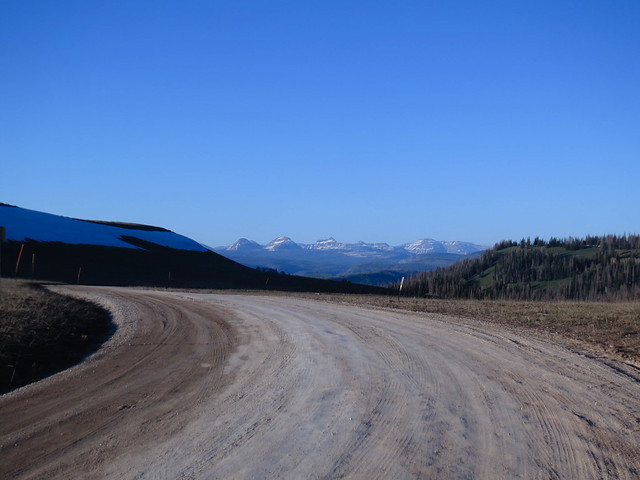 |
| Somewhere between Heber and Wolf Creek Pass with High Uintas in view. Day 1. |
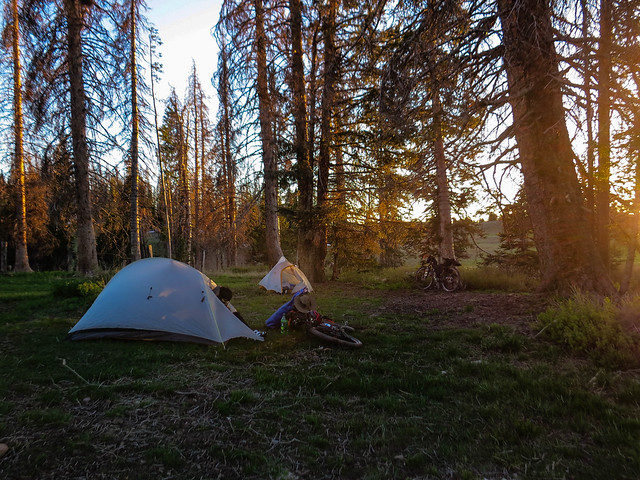 |
| Camp 1 in the Uinta National Forest |
Day 2: We awoke early, anxious to get to Wolf Creek Pass. On Duchesne Ridge, we were met with snow. Much of the time, we were able to ride our rigs across the frozen snow. Sometimes though we were met with muck and slush. We connected to pavement at Wolf Creek Pass and descended through Hanna and Tabiona, and then rode to Duchesne. From Duchesne, our GPS route led us into an alfalfa field. After we got that straightened out, we pushed out of Myton into a brutal headwind, riding through the Uinta Basin and the thumping of oil/gas wells. A few minutes before all the light of the day was gone, we turned off the road and set up camp. On a scale of 1-10 with 10 being "I wish I had a flame thrower," swarming gnats were a solid 9. We threw up our tents and dived inside for cover. 101 miles, 4044 vertical, and 14 hour day.
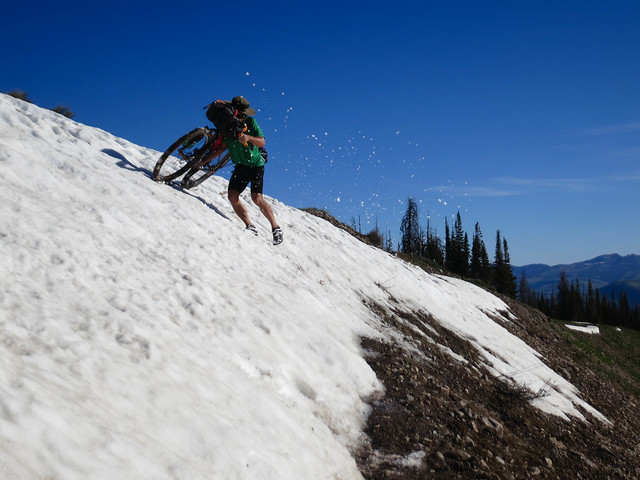 |
| Aaron fighting his bike and the "Pig" (his drybag strapped onto his rack) on Duchesne Ridge |
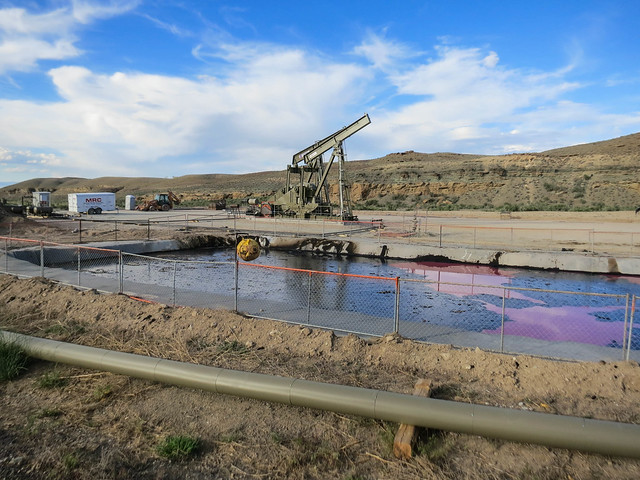 |
| Oil Wells in the Uinta Basin |
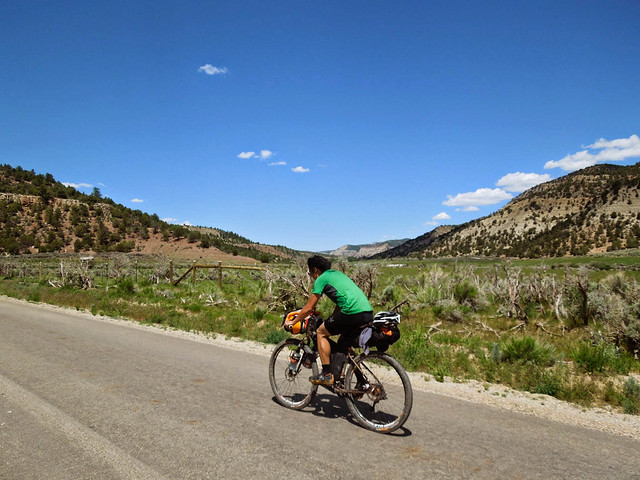 |
| Nine Mile Canyon was dotted with mostly-abandoned ranches. |
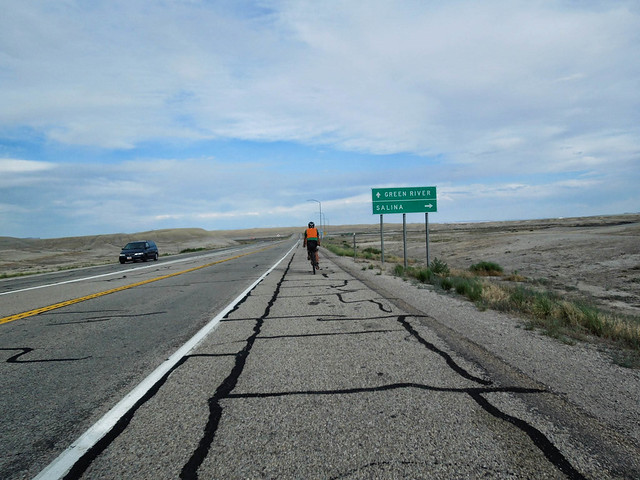 |
| I found an orange safety vest on the side of the road near Duchesne. I was glad to have found it and wore it religiously when our route went on the pavement. About to merge onto I-70. |
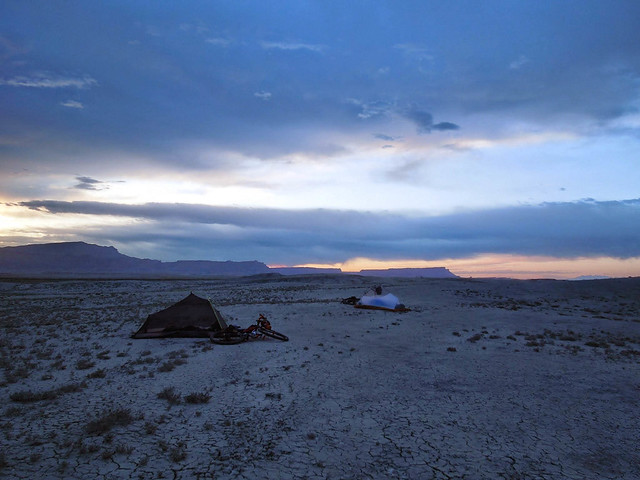 |
| Day 3: We pitched our tents in the cracked desert outside of Green River. We awoke to threatening clouds and barely got our gear packed before a short but strong dust storm. |
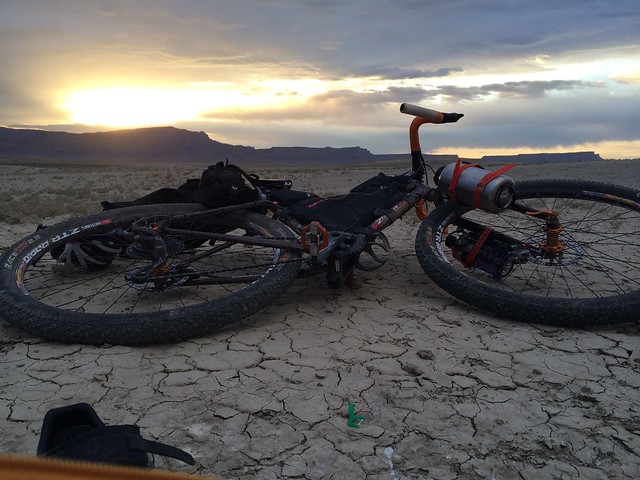 |
| Good morning Green River! |
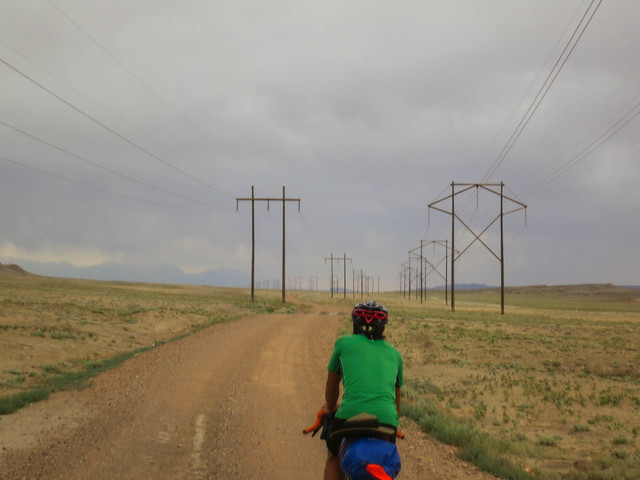 |
| If we are riding on rubber under power lines during an electrical storm . . . ? Outside of Moab. |
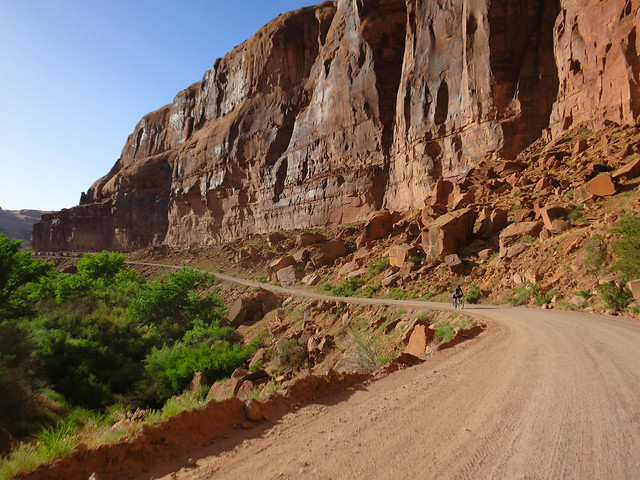 |
| Kane Creek road leading to Hurrah Pass. |
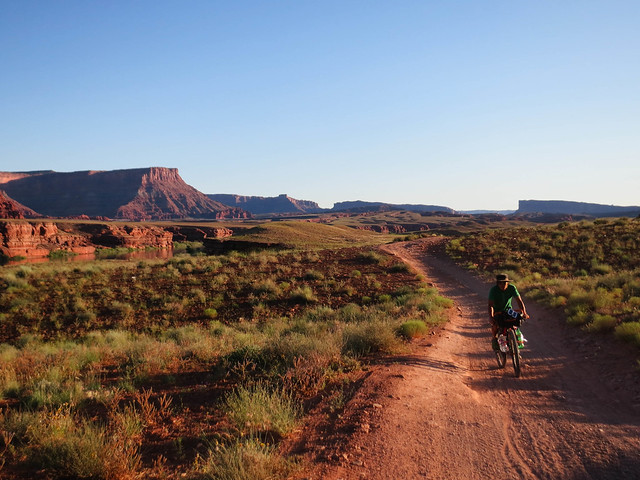 |
| Early morning light on Lockhart Basin road. We got an early start, hoping to avoid the heat of the day. |
 |
| At one point, the road almost touches the Colorado River. |
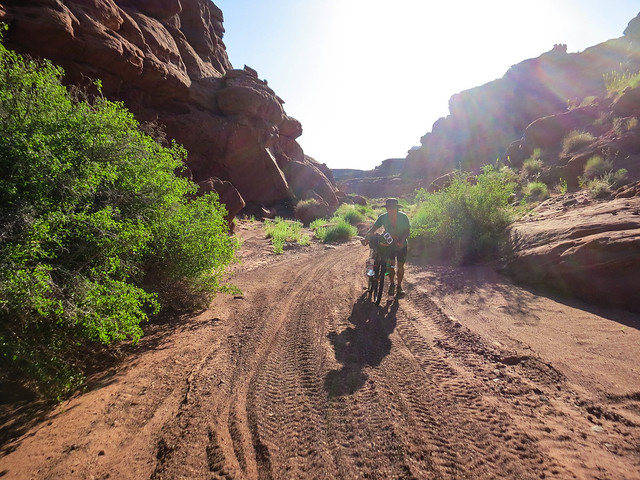 |
| The GPS said we were on track, ATVs had followed this track, but it didn't seem like the right track. Aaron pushing through sand. |
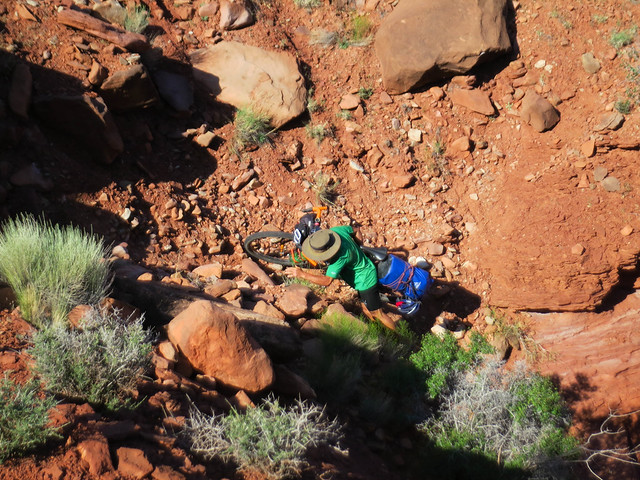 |
| Things got ugly. |
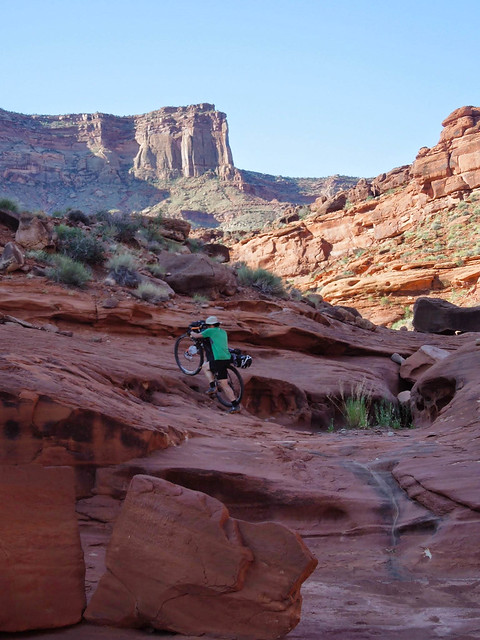 |
| And then dire. I'm a cyclist, not a power lifter, or a cross-fitter. |
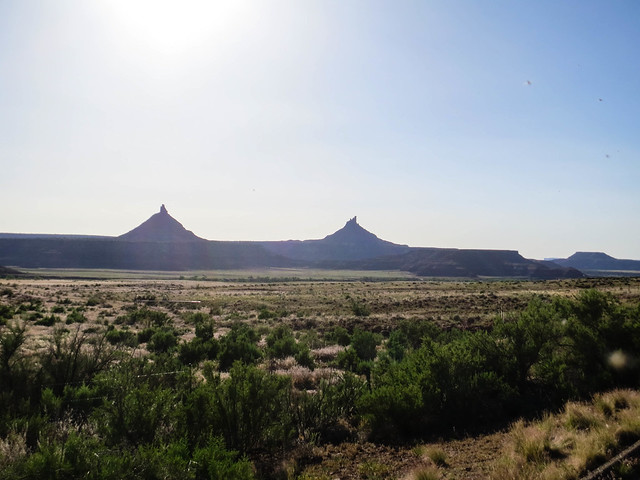 |
| Indian Creek |
 |
| Me, riding over the top of the Manti Lasal range, onto the Elk Ridge Road. |
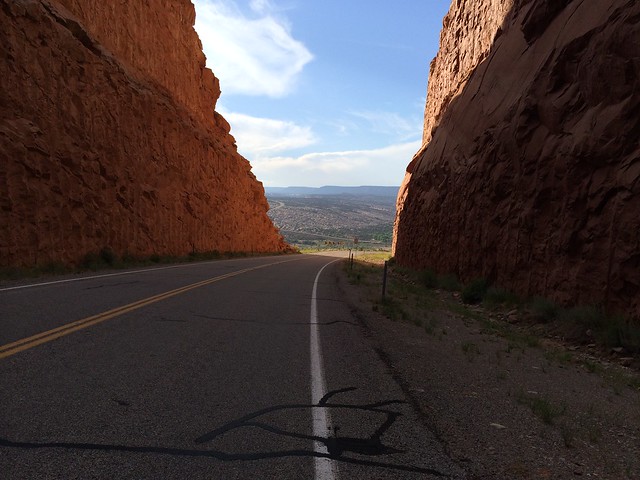 |
| This road cuts through a massive formation between Blanding and Hanksville. |
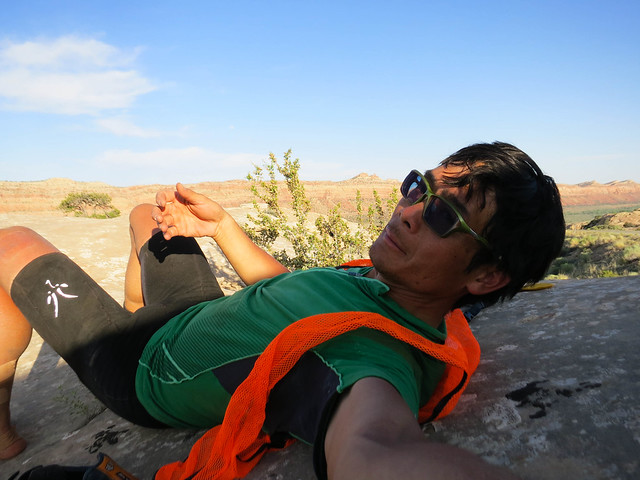 |
| It's been a long day. More pedaling to come though. |
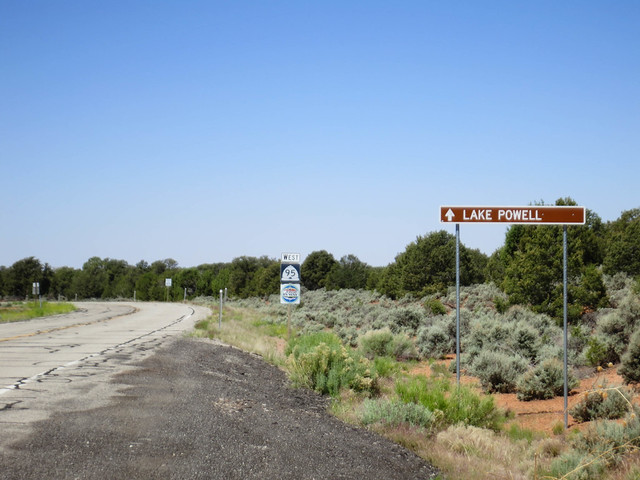 |
| Having a destination was motivating and, at times, daunting. |
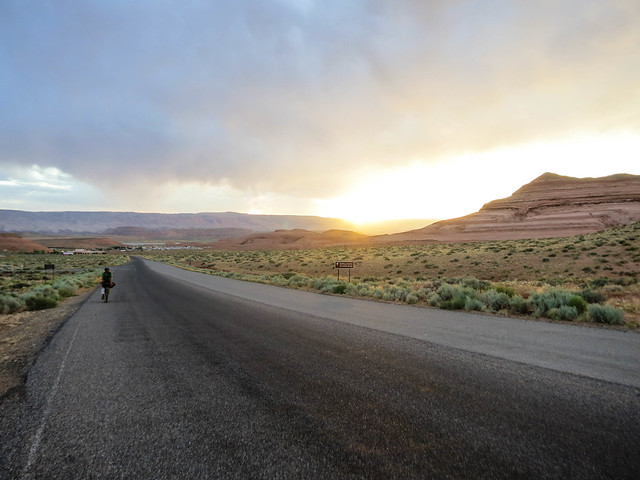 |
| Aaron pedaling out of Bullfrog Bay. |
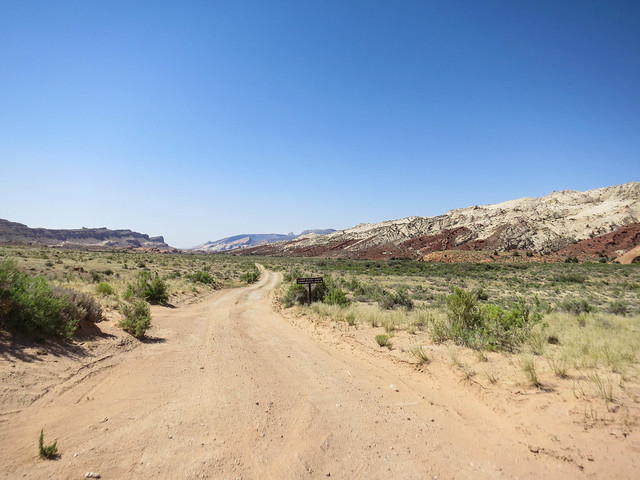 |
| The waterpocket fold in Capitol Reef National Park. |
 |
| Aaron climbing up the Burr Trail switchbacks. |
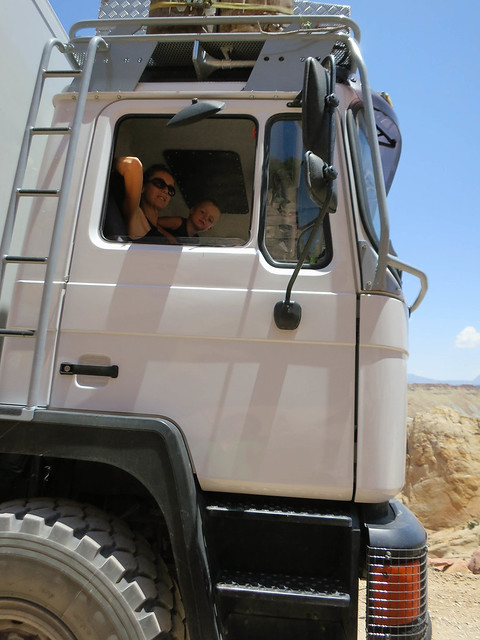 |
| This nice French lady asked if I needed water. Never turn down water in the desert. |
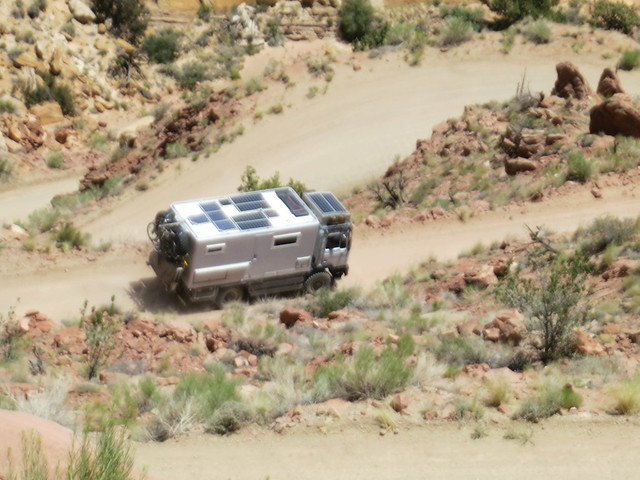 |
| What a cool expedition vehicle -- a customized MAN (the brand). |
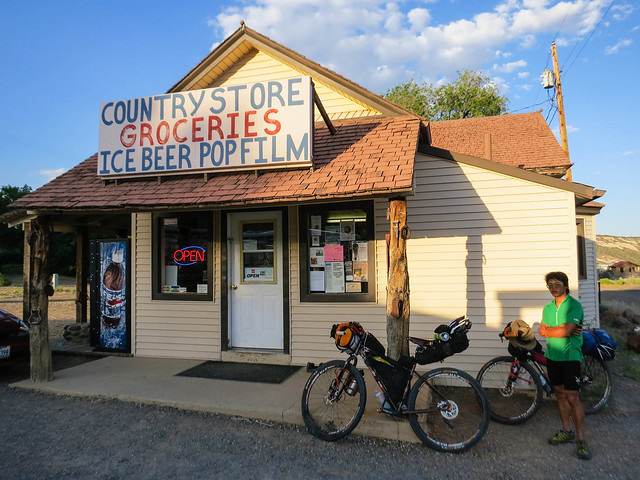 |
| Stocking up at a the "Country Store" in Boulder, Utah. |
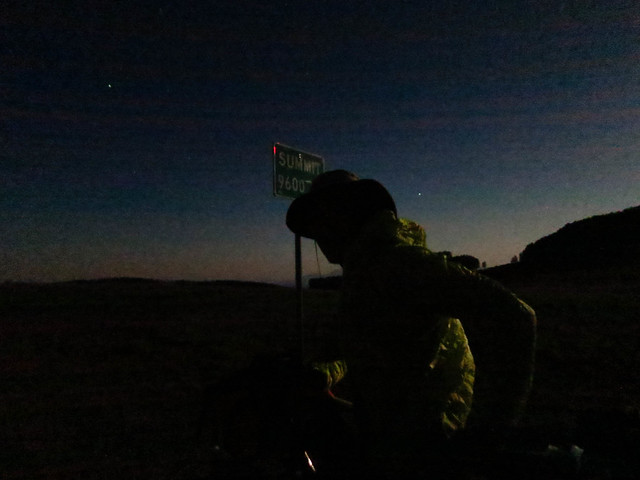 |
| At the summit of the Aquarius Plateau at about 10:30 at night. Riding at night under a full moon was energizing. |
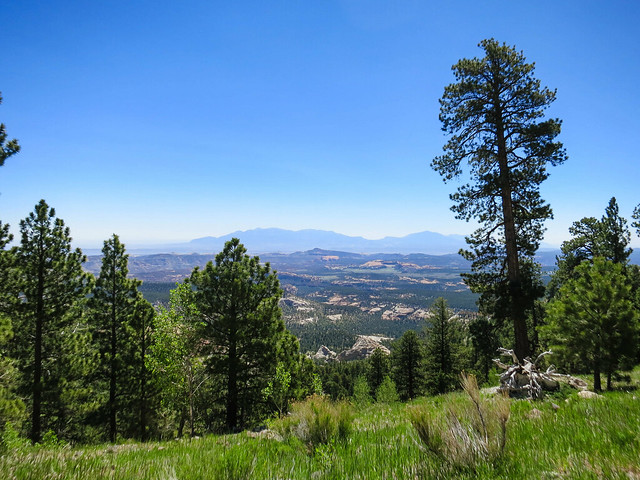 |
| View from the top of the Boulder Mountain, looking down towards the Burr Trail, the Henry Mountains, and Lake Powell. Riding through the Henry Mountains sounds interesting. |
Wednesday, June 4, 2014
My Foray into Bikepacking -- SLC > Moab > Lake Powell > Torrey > SLC
I've always thought it would be cool to ride a bike to Lake Powell via mostly dirt roads. I've talked about it, thought about it, but never have done it. So, when my brother Aaron indicated an interest in bikepacking, I knew my chance had come.
I bought a bike. It is steel and not very light, which is good because it needs to carry me, gear, and food for a lot of miles over some pretty rough terrain.

The bike is a Salsa Fargo, a mountain bike with drop bars, which is perfect for riding on rough dirt roads. There is a difference between a mountain bike with drop bars and a cross bike. A cross bike isn't as capable or comfortable or as heavy.
Tomorrow, brother Aaron and I are going to start from my driveway, ride up Big Cottonwood, to Tabiona, Nine Mile Canyon, Price, some desert roads to Moab, Lockhart Basin, Beef Basin, over the Abajo mountains, to Bullfrog Lake Powell. Since the ferry crashed and is closed, we hope to hitch/buy a ride to the other side. Then we will proceed up the Burr Trail, to Boulder, to Torrey, to Fishlake, Johnson Reservoir, catch the Skyline drive at I-70 and ride it to Highway 6, cross over and ride to Strawberry Reservoir, through Heber, and back to SLC.
It will be a long journey. It will be a hard journey -- approximately 900 miles and 80,000 vertical feet. There is a pretty good chance we will not make it or complete it in the time we have (10 days). But we are going to try and we know we will have an adventure.
Here is a rough map of our proposed route:
Initially, I wanted to ride through the Ouray Ute Indian Reservation to Moab, but it's against the law, and I was told I'd get in big trouble. So, there is a large chunk between Price and Moab that will be on pavement. There is also a chunk of pavement from the Abajos to Lake Powell. And of course from SLC to Tabiona. Other than that, most will be on backcountry dirt roads.
Since we will be mostly in the backcountry, we have to be relatively self-sustained. It's been a challenge figuring out how to carry all the gear we need plus 4 days worth of food. But, it's come together, and now all we have to do is pedal.
I bought a bike. It is steel and not very light, which is good because it needs to carry me, gear, and food for a lot of miles over some pretty rough terrain.
The bike is a Salsa Fargo, a mountain bike with drop bars, which is perfect for riding on rough dirt roads. There is a difference between a mountain bike with drop bars and a cross bike. A cross bike isn't as capable or comfortable or as heavy.
Tomorrow, brother Aaron and I are going to start from my driveway, ride up Big Cottonwood, to Tabiona, Nine Mile Canyon, Price, some desert roads to Moab, Lockhart Basin, Beef Basin, over the Abajo mountains, to Bullfrog Lake Powell. Since the ferry crashed and is closed, we hope to hitch/buy a ride to the other side. Then we will proceed up the Burr Trail, to Boulder, to Torrey, to Fishlake, Johnson Reservoir, catch the Skyline drive at I-70 and ride it to Highway 6, cross over and ride to Strawberry Reservoir, through Heber, and back to SLC.
It will be a long journey. It will be a hard journey -- approximately 900 miles and 80,000 vertical feet. There is a pretty good chance we will not make it or complete it in the time we have (10 days). But we are going to try and we know we will have an adventure.
Here is a rough map of our proposed route:
Initially, I wanted to ride through the Ouray Ute Indian Reservation to Moab, but it's against the law, and I was told I'd get in big trouble. So, there is a large chunk between Price and Moab that will be on pavement. There is also a chunk of pavement from the Abajos to Lake Powell. And of course from SLC to Tabiona. Other than that, most will be on backcountry dirt roads.
Since we will be mostly in the backcountry, we have to be relatively self-sustained. It's been a challenge figuring out how to carry all the gear we need plus 4 days worth of food. But, it's come together, and now all we have to do is pedal.
Tuesday, June 3, 2014
Family Adventuring in Southern Utah
Tuesday, March 11, 2014
How Rando Racing Boots Have Shaped Mainstream Alpine Touring Boots
When it comes to ski boots, I feel like I have experienced a lot. My history is as follows:
1. leather xc 3 pin boots;
2. Merrell Fusion telemark boots -- these boots were leather fused to a plastic toe and heel;
3. full plastic Garmont telemark boots;
4. Scarpa T1 telemark boots;
5. Scarpa Laser AT boots;
6. Scarpa F1 AT boots (3-4 pair);
7. Scarpa Matrix AT boots;
8. Dynafit TLT Race boots (old school version with velcro upper fastener);
9. Dynafit Zzero Green Machine AT boots;
10. Dynafit DyNA Race boots;
11. Scarpa Alien Race boots;
12. La Sportiva Spitfire AT boots;
13. Pierre Gignoux 444 Race boots;
14. Pierre Gignoux Morpho Race boots;
15. La Sportiva Spectre AT boots.

As I write out this list, I wonder if I've missed any. Maybe I have, but these are the ones that stick out. I'm uncertain as to whether to be proud or embarrassed about this list. It definitely is not an illustration of fiscal responsibility or sustainability. One day, I might have to explain to my son that I spent his college tuition on ski boots. On the other hand, I can say that I have gone to school of ski touring boots. As a result of the "list," I have a keen sense of the good, bad, and the ugly.
Way back when when things were simple, which was really only a decade ago, boots were boots. Boots attached to skis and I put my feet into them to go ski. Those were happy times. But they were also slow and unsteady times. No free pivot. And to get down the hill, you needed to drop a soulful knee.
Scarpa's F1 was revolutionary. I remember the hype before it came out. I remember scouring telemarktips.com for info and beta on what was then considered to be more of a concept boot. I remember AT Apostle bragging that he was posting on ttips while wearing a pair of F1s. F1s were rad. They were lime green. At the first ever Powder Keg, I remember seeing them for the first time. They were unlike anything available at the time. They walked well, even better than telemark boots. They were relatively light -- much light than a Scarpa T1. And they skied down with a fixed heel. The Euros went crazy with them, drilling them out to make them lighter and a cottage industry (in a literal sense) specializing in F1 boot mods was formed.

As I write this off-the-cuff rendition of AT boot history, it occurs to me that Dynafit may have lead the charge into the world of light, walkable, skiable boots. I'm pretty sure Dynafit's Mountain Lite/TLT line came before Scarpa's F1. In any event, early on, it's certain that Scarpa's F1 was much more ubiquitous. Dynafit's time would come though.


As racers whittled, drilled, and modified the Scarpa F1 to suit their needs, others came up with other alternatives. Benedikt Bohm took a Dynafit TLT boot lower, and then fitted it with a carbon upper and a throw reminiscent of a Scarpa F1 throw. I think he might have skied off a 8,000 meter peak on that boot. And then guys like Pierre Gignoux started building all-carbon boots in his garage. Pierre was a top racer (once holding the record for the fastest ski ascent and descent of Mont Blanc) looking for a top solution. He built a boot, loosely modeled after the F1's rear one-step lock down rear throw. This boot was much much lighter than its pebax cousins.
Taking a step back, I think that for several years, the backcountry community viewed the F1 and its iterations, and perhaps those who used them, as outliers. These were not boots to seriously consider for serious touring or mountaineering. While more legitimate than a gimmick, they weren't a "real" AT boot. In a sense, this sentiment was correct. The F1 had a pretty awkward fastening system. The heel throw was bulky and got in the way. The duck-billed, bellowed toe was not ideal for rock climbing and mountaineering. Later F1 versions addressed these issues with slimmer and ergonomic heel throws. The duckiness of the bill was likewise eliminated.

This is not to say that people, like myself, did not resort solely to the F1 as a backcountry boot. The truth is, after experiencing the walkability and efficiency of a F1, how could we happily ski anything else? I tried to ski the Scarpa Matrix and the ZZero Green Machine, but was frustrated with their inefficiency on the uptrack. Skiing those boots was like putting my ankles in casts.
Then Dynafit came out with the DyNA Race boot. While racing in Europe, I bought a pair. These boots were substantially lighter than the F1. I think of these boots as a refined version of Benedikt Bohm's modified TLTs. I speculate that because Scarpa protected rights to its heel throw, Dynafit did/could not incorporate that in its mass production boot. Dynafit came out with the side-throw. Like Bohm's custom boots, the upper cuff was carbon fiber. Like the F1, transitioning from walk to ski mode was a one-step process. The DyNAs were superior to the F1s in weight, walkability, and skiability. I quickly adopted the DyNA as my do everything boot. My speed ascent/descent of the Grand Teton was in DyNAs.

The DyNa Race boot certainly had an impact in the race world. It was one of the first mainstream boots to compete with the F1 (in contrast to garage-made boots). But I think the true significance of the DyNa is that it gave birth to Dynafit's wildly successful TLT 5 boot. I view the TLT 5 as the boot that bridged the fringe group of racers with the core backcountry community. The TLT 5 was a real and acceptable boot for racers, backcountry tourers, and ski mountaineers alike.

The thing about all race-bred boots from the F1 forward is that they all had a highly articulable cuff. Yes, weight was reduced. Yes, the fastening system was a one-step process. But the most important characteristic of these boots in my mind is the walkability of these boots. Rather than being alpine-boots-made-to-walk, these were first and foremost walking-boots-made-to-ski. And this makes a lot of sense. For any backcountry skier or ski mountaineer, the majority -- I would say 90 percent -- of time "skiing" is spent walking. If I were forced to choose between weight and walkability, I would choose walkability. Because walking with two chunky casts on my ankles is simply not fun.
Nowadays in the Wasatch, it is not uncommon to see a TLT 5 or a TLT 6. Four years ago, I'm pretty sure I knew everyone on who owned a pair. My choice is La Sportiva's Spitfire, a true backcountry and mountaineering boot that I chose to employ in my ski ascent and descent of Denali. Still, for every skier in TLTs, Spitfires, or F1s, I see several skiers in big-not-very-walkable AT boots. And by that I mean everything from Scarpa's Maestrale to Dynafit's ZZero/Titan to Black Diamond's Prime/Quadrants. I'm not saying these boots are bad boots. I'm sure they ski very nicely. But for me, if I'm spending most of my day walking, I also want a boot to do that nicely too. And while I am admittedly odd, I don't think that is an odd preference.

So why do people persist in skiing in not-very-walkable boots? I'm sure many eventually change when they upgrade their setup. Not everyone buys one or two pair of boots a year. But I think the real reason is that the largest backcountry segment is willing to compromise walkability for skiability. Case in point: just last week I skinned past a guy in Lange alpine boots, Marker bindings, and alpine skis. I'm sure his setup weighed 4 times what mine weighed. 4 hours later, I saw this same guy. He had just skied the South Face of Superior solo on a considerable avalanche day. This was a hard core dude. And he was willing to haul around 14 pounds per foot because he wanted performance on the down. To each his own. I respect that.
But, what if you could have walkability and skiability? It's not far off. When it comes to boots, this is the future of the ski industry's only growing segment. It's not reasonable to think that everyone will become racers and buy into the pure race mentality. But it is reasonable to think that if given a choice between a boot that skis well and walks well and a boot that skis well and doesn't walk well, skiers will choose the former. Every time.
I said the time is not far off when mainstream ski tourers (as opposed to extreme racer fanatics) can have a boot that really skis and really walks. That was not completely true, because there is one such boot out there: Sportiva's Spectre. It's a four buckle boot that is as supportive as most alpine boots. And it walks like a TLT 5/Spitfire.
The history of AT boots is rather short. It's been interesting and admittedly satisfying to see the radical rando racing segment of the sport inform and arguably transform the accepted norms of backcountry skiing. It's been interesting to see various companies innovate and compete. In particular, it's interesting that while Scarpa got the ball rolling with its F1, Dynafit advanced the baton substantially with its TLT 5. Scarpa really had no answer for a couple years although its new and improved F1 is exciting. Sportiva answered Dyanfit's TLT 5 and the demand for a ski boot with racing roots with its Spitfire. Its soon-to-come Cyborg will provide even yet another alternative.
The trickle down (or is it up?) effect of rando racing boots has not ended. Sportiva is successfully implementing the best characteristics of the race-bred boots into bigger boots like the Spectre -- a walkable, skiable, and amazingly light four buckle boot. No one so far as I know has an answer to that. Yet.
1. leather xc 3 pin boots;
2. Merrell Fusion telemark boots -- these boots were leather fused to a plastic toe and heel;
3. full plastic Garmont telemark boots;
4. Scarpa T1 telemark boots;
5. Scarpa Laser AT boots;
6. Scarpa F1 AT boots (3-4 pair);
7. Scarpa Matrix AT boots;
8. Dynafit TLT Race boots (old school version with velcro upper fastener);
9. Dynafit Zzero Green Machine AT boots;
10. Dynafit DyNA Race boots;
11. Scarpa Alien Race boots;
12. La Sportiva Spitfire AT boots;
13. Pierre Gignoux 444 Race boots;
14. Pierre Gignoux Morpho Race boots;
15. La Sportiva Spectre AT boots.

As I write out this list, I wonder if I've missed any. Maybe I have, but these are the ones that stick out. I'm uncertain as to whether to be proud or embarrassed about this list. It definitely is not an illustration of fiscal responsibility or sustainability. One day, I might have to explain to my son that I spent his college tuition on ski boots. On the other hand, I can say that I have gone to school of ski touring boots. As a result of the "list," I have a keen sense of the good, bad, and the ugly.
Way back when when things were simple, which was really only a decade ago, boots were boots. Boots attached to skis and I put my feet into them to go ski. Those were happy times. But they were also slow and unsteady times. No free pivot. And to get down the hill, you needed to drop a soulful knee.
Scarpa's F1 was revolutionary. I remember the hype before it came out. I remember scouring telemarktips.com for info and beta on what was then considered to be more of a concept boot. I remember AT Apostle bragging that he was posting on ttips while wearing a pair of F1s. F1s were rad. They were lime green. At the first ever Powder Keg, I remember seeing them for the first time. They were unlike anything available at the time. They walked well, even better than telemark boots. They were relatively light -- much light than a Scarpa T1. And they skied down with a fixed heel. The Euros went crazy with them, drilling them out to make them lighter and a cottage industry (in a literal sense) specializing in F1 boot mods was formed.

As I write this off-the-cuff rendition of AT boot history, it occurs to me that Dynafit may have lead the charge into the world of light, walkable, skiable boots. I'm pretty sure Dynafit's Mountain Lite/TLT line came before Scarpa's F1. In any event, early on, it's certain that Scarpa's F1 was much more ubiquitous. Dynafit's time would come though.


As racers whittled, drilled, and modified the Scarpa F1 to suit their needs, others came up with other alternatives. Benedikt Bohm took a Dynafit TLT boot lower, and then fitted it with a carbon upper and a throw reminiscent of a Scarpa F1 throw. I think he might have skied off a 8,000 meter peak on that boot. And then guys like Pierre Gignoux started building all-carbon boots in his garage. Pierre was a top racer (once holding the record for the fastest ski ascent and descent of Mont Blanc) looking for a top solution. He built a boot, loosely modeled after the F1's rear one-step lock down rear throw. This boot was much much lighter than its pebax cousins.
Taking a step back, I think that for several years, the backcountry community viewed the F1 and its iterations, and perhaps those who used them, as outliers. These were not boots to seriously consider for serious touring or mountaineering. While more legitimate than a gimmick, they weren't a "real" AT boot. In a sense, this sentiment was correct. The F1 had a pretty awkward fastening system. The heel throw was bulky and got in the way. The duck-billed, bellowed toe was not ideal for rock climbing and mountaineering. Later F1 versions addressed these issues with slimmer and ergonomic heel throws. The duckiness of the bill was likewise eliminated.

This is not to say that people, like myself, did not resort solely to the F1 as a backcountry boot. The truth is, after experiencing the walkability and efficiency of a F1, how could we happily ski anything else? I tried to ski the Scarpa Matrix and the ZZero Green Machine, but was frustrated with their inefficiency on the uptrack. Skiing those boots was like putting my ankles in casts.
Then Dynafit came out with the DyNA Race boot. While racing in Europe, I bought a pair. These boots were substantially lighter than the F1. I think of these boots as a refined version of Benedikt Bohm's modified TLTs. I speculate that because Scarpa protected rights to its heel throw, Dynafit did/could not incorporate that in its mass production boot. Dynafit came out with the side-throw. Like Bohm's custom boots, the upper cuff was carbon fiber. Like the F1, transitioning from walk to ski mode was a one-step process. The DyNAs were superior to the F1s in weight, walkability, and skiability. I quickly adopted the DyNA as my do everything boot. My speed ascent/descent of the Grand Teton was in DyNAs.
The DyNa Race boot certainly had an impact in the race world. It was one of the first mainstream boots to compete with the F1 (in contrast to garage-made boots). But I think the true significance of the DyNa is that it gave birth to Dynafit's wildly successful TLT 5 boot. I view the TLT 5 as the boot that bridged the fringe group of racers with the core backcountry community. The TLT 5 was a real and acceptable boot for racers, backcountry tourers, and ski mountaineers alike.

The thing about all race-bred boots from the F1 forward is that they all had a highly articulable cuff. Yes, weight was reduced. Yes, the fastening system was a one-step process. But the most important characteristic of these boots in my mind is the walkability of these boots. Rather than being alpine-boots-made-to-walk, these were first and foremost walking-boots-made-to-ski. And this makes a lot of sense. For any backcountry skier or ski mountaineer, the majority -- I would say 90 percent -- of time "skiing" is spent walking. If I were forced to choose between weight and walkability, I would choose walkability. Because walking with two chunky casts on my ankles is simply not fun.
Nowadays in the Wasatch, it is not uncommon to see a TLT 5 or a TLT 6. Four years ago, I'm pretty sure I knew everyone on who owned a pair. My choice is La Sportiva's Spitfire, a true backcountry and mountaineering boot that I chose to employ in my ski ascent and descent of Denali. Still, for every skier in TLTs, Spitfires, or F1s, I see several skiers in big-not-very-walkable AT boots. And by that I mean everything from Scarpa's Maestrale to Dynafit's ZZero/Titan to Black Diamond's Prime/Quadrants. I'm not saying these boots are bad boots. I'm sure they ski very nicely. But for me, if I'm spending most of my day walking, I also want a boot to do that nicely too. And while I am admittedly odd, I don't think that is an odd preference.

So why do people persist in skiing in not-very-walkable boots? I'm sure many eventually change when they upgrade their setup. Not everyone buys one or two pair of boots a year. But I think the real reason is that the largest backcountry segment is willing to compromise walkability for skiability. Case in point: just last week I skinned past a guy in Lange alpine boots, Marker bindings, and alpine skis. I'm sure his setup weighed 4 times what mine weighed. 4 hours later, I saw this same guy. He had just skied the South Face of Superior solo on a considerable avalanche day. This was a hard core dude. And he was willing to haul around 14 pounds per foot because he wanted performance on the down. To each his own. I respect that.
But, what if you could have walkability and skiability? It's not far off. When it comes to boots, this is the future of the ski industry's only growing segment. It's not reasonable to think that everyone will become racers and buy into the pure race mentality. But it is reasonable to think that if given a choice between a boot that skis well and walks well and a boot that skis well and doesn't walk well, skiers will choose the former. Every time.
I said the time is not far off when mainstream ski tourers (as opposed to extreme racer fanatics) can have a boot that really skis and really walks. That was not completely true, because there is one such boot out there: Sportiva's Spectre. It's a four buckle boot that is as supportive as most alpine boots. And it walks like a TLT 5/Spitfire.
The history of AT boots is rather short. It's been interesting and admittedly satisfying to see the radical rando racing segment of the sport inform and arguably transform the accepted norms of backcountry skiing. It's been interesting to see various companies innovate and compete. In particular, it's interesting that while Scarpa got the ball rolling with its F1, Dynafit advanced the baton substantially with its TLT 5. Scarpa really had no answer for a couple years although its new and improved F1 is exciting. Sportiva answered Dyanfit's TLT 5 and the demand for a ski boot with racing roots with its Spitfire. Its soon-to-come Cyborg will provide even yet another alternative.
The trickle down (or is it up?) effect of rando racing boots has not ended. Sportiva is successfully implementing the best characteristics of the race-bred boots into bigger boots like the Spectre -- a walkable, skiable, and amazingly light four buckle boot. No one so far as I know has an answer to that. Yet.
Monday, January 6, 2014
Tuesday, November 12, 2013
A Fishing Story To Remember
On Saturday, my family hopped in my drift boat for a fall fishing session on Strawberry Reservoir. We wind drifted and trolled flies on a fly rod and two spin rods. Immediately, we had success, and we were happy. My 5 year old was using my fly rod. After catching 4 or so nice big cutts, he lost a bit of focus. Before we knew it, he had a fish on, and the fly rod went rocketing out of the boat. I watched as the rod, reel, and orange backing zoomed away through the water. It was a helpless feeling. I liked that rod and it had served me well the last 12 years. I thought it was gone. My little boy felt bad, and I scolded him and told him it was ok at the same time. But again, in my mind, I was feeling the loss.
 |
| Here's the little guy before the rod rocketed out of his hands. |
 |
| The line angling down and to the left is my daughter's. You can see the fly hooked to the fly rod line. |
Subscribe to:
Comments (Atom)
